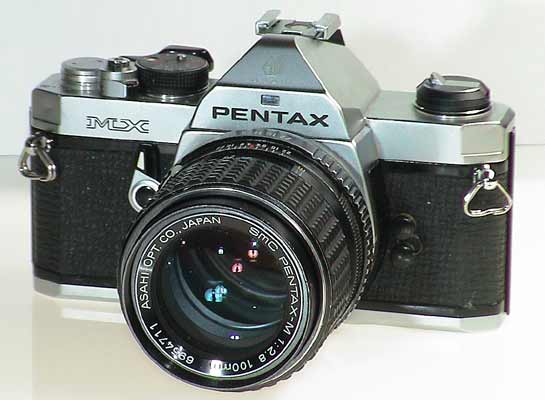Jeg
har ett kamera igjen som jeg hadde tenkt å beholde,
etter at jeg solgte det meste og kjøpte digitalt utstyr.
Dette er mitt favorittkamera: Pentax MX med SMC-M 100mm f.2.8. Kameraet
er meget raskt å bruke. Tydelige lysdioder i søkeren
viser korrekt innstilt eksponering. Blederinnstillingen vises øverst
og lukkertid til høyre i søkerbildet. Kamerahuset er
meget pent og lite brukt.
Objektivet er uten riper og skader på glasset, uten feil, men
bærer preg av
normal slitasje på blenderringen. Dvs. den sorte lakken er litt
slitt på kantene der jeg har holdt fingrene, se bildet.
Jeg har nettopp hadd kameraet til kontroll og justering hos Pentax-importøren.
Dette kostet kr 892,- med ett års garanti.
Gi bud.
Kopi av servicen vedlegges.
Jeg har karakter +30 på QXL for salg jeg har hadd.
Dette er faktisk et av de minste og mest kompakte kamerahus, konstruert
med mekanisk lukker slik at du kan ta bilder selv om lysmålerbatteriet
blir utladet. PS. Dette huset ser du ikke ofte tilsalgs.
Dette
objektivet gir utrolig bra bilder.
Les hvrfor:
"
About Super-Multi Coating (SMC)
Refraction and Partial Reflection
Light refracts (bends) when it travels through a border between two
transparent substances with different densities. In particular, it
bends when leaving air and entering glass and also when leaving glass
and entering air. Under ideal conditions all light will bend, but
in real life about 95% bends and 5% is reflected back into the first
substance.
With photographic lenses this is a serious problem because less light
reaches the film surface. For a lens with n optical groups (hence
2n refraction surfaces) and coefficient of refraction r (the percentage
of refracted light divided by 100), only a fraction L reaches the
film, and L = r 2n. For r = 0.95 and n = 10, L = 0.36. This means
that only 36% of the light reaches the film. The rest is scattered
around, and some of it results in undesirable ghost images or flare.
Super Multi-Coating
To combat the undesirable consequences of partial reflection, scientists
developed chemical coatings to be applied to glass surfaces. These
coatings increase r, and in the case of Pentax's famous Super Multi-Coating
(SMC), r = 0.998! Performing the above calculation for a lens with
10 groups, we get L = 0.96, or only 4% light loss.
SMC was patented and first applied in 1971, when Pentax was still
making screw mount equipment. To highlight the fact that the lens
elements were super multi-coated, Pentax renamed their lens lines
from Takumar and Super-Takumar to Super-Multi-Coated Takumar and later
on to SMC Takumar.
Nowadays, with K-mount equipment, SMC is used for lens, filters, some
body optics and various accessories. Most Pentax lenses are SMC-coated.
All SMC-coated lenses have "SMC" in their name. The few
lenses that do not have SMC are low-budget items, and bear no "SMC"
in their name. They all have some form of coating, some of them even
multi-layer, but not the patented SMC.
Benefits from SMC
In reference 06671, Pentax claims that SMC is "a remarkable seven-layer
lens coating process that cuts the reflection ratio down to just 0.2%
per lens surface. The result is a dramatic improvement in both color
fidelity and brightness and the elimination of flare and ghost images."
In the meantime, all optics manufacturers have developed some form
of surface coating, and each claims "superior performance."
In practice, most tests point that Pentax's SMC is still the best
of all mainstream solutions".
Salg
index

